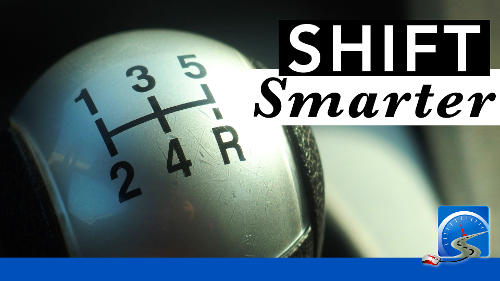Shift smarter, not harder!
Overview
• Downshifting to slow the vehicle is an old driving technique that originated in the 1940s when brakes were unreliable.
• Rev matching and heel-toe shifting are racing techniques. These require huge amounts of practice to master and do well. Done improperly these driving techniques will wear out your clutch and drivetrain.
• For downshifting on hills, learn to double clutch to reduce wear on your vehicle and get a smooth shift.
• Using only the brakes to slow the vehicle gives you more control, especially in slippery conditions.
• When slowing in a manual car, simply brake until the tachometer drops to 1,000rpm and then push in the clutch. When the vehicle comes to a complete stop shift back to first gear. OR shift to the appropriate gear for the speed you're travelling.
• DO NOT take the selector out of gear and coast in neutral.
• When decsending long downgrades DO use the transmission to aid in maintaining a safe descent speed.
• On a road test, students are taught to downshift so they learn to match gears with the vehicle's speed.
• Modern braking systems won't fail because of advances in automotive technology. Also, braking systems are divided into 2 independent subsystems. If one fails, the other will continue to work normally.
Closed Caption
Updated Jan 2021
Introduction
 Why would you use a $15,000 drive train to slow a vehicle in an attempt to save $400 brakes.Hi there smart drivers, Rick with Smart Drive Test talking to you today about downshifting and that you shouldn't do it.
Why would you use a $15,000 drive train to slow a vehicle in an attempt to save $400 brakes.Hi there smart drivers, Rick with Smart Drive Test talking to you today about downshifting and that you shouldn't do it.
Is it bad to downshift a manual car?
I had a comment from Christopher Kibler:
"He said that on snow and ice you need to use the braking force from the engine."
Which actually is not true, because on skid pads they've done tests and shown that if you lock up the back wheels on slippery conditions you could lose control of the vehicle.
So when you're down shifting, you could lock up the back wheels, lose control, crash into a tree and die in a fiery inferno.
The other question I asked you about downshifting is:
"Why would you use a $15,000 drivetrain to save $400 brakes, and downshift?"
And actually, I too was once of that habit.
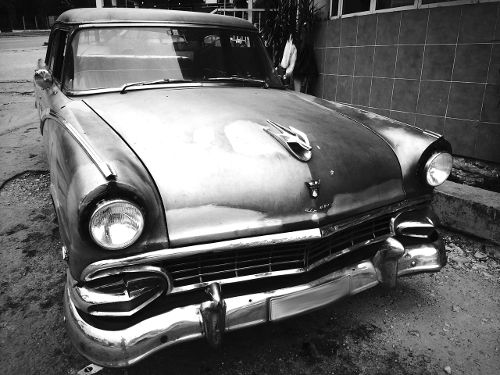 Before the 1970s, brake were unreliable. To compensate drivers downshifted the transmission to assist in slowing the vehicle.But some years ago somebody asked me that in a big truck - why was I downshifting when I was just using fuel?
Before the 1970s, brake were unreliable. To compensate drivers downshifted the transmission to assist in slowing the vehicle.But some years ago somebody asked me that in a big truck - why was I downshifting when I was just using fuel?
Because on a big truck, you have to match rev - you have to rev the motor up to match the gear when you go down to the lower gear.
And you're just using fuel.
And I started to reconsider my approach to driving and now I don't downshift at all.
I simply just use the brakes.
So what we're going to do today, we're going to go for drive and show you how to drive a manual transmission without downshifting.
Because you don't need to downshift.
Now just let me clarify on one point: if you're going down long downgrades, yes you do need to downshift and you need the engine braking to assist in bringing that vehicle down the steep long downgrade.
Especially if you're driving a bigger vehicle - you do need to do that as well!
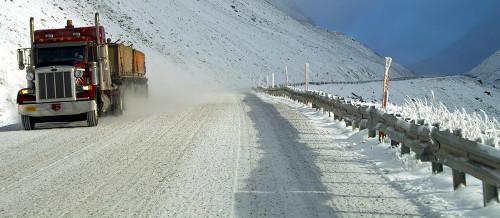 When going down long, steep downgrades use the transmission to assist in braking to avoid brake failure.And racing, yes they do downshift so they can shoot out of the corner, because they're accelerating harder in a lower gear.
When going down long, steep downgrades use the transmission to assist in braking to avoid brake failure.And racing, yes they do downshift so they can shoot out of the corner, because they're accelerating harder in a lower gear.
We're not talking about either one of those things - we're NOT talking about braking on long downgrades and we're NOT talking about downshifting for the purpose of racing and shooting out the corner on the other side.
This information is about everyday driving in a manual car. It's neither for downhill braking nor racing.
We're not talking about either one of those.
We are simply talking about everyday driving.
So stick around, we'll be right back with that information.
[OPENING CREDITS & MUSIC]
Hi there smart drivers.
Welcome back, Rick with Smart Drive Test talking to you today about downshifting and that for most everyday driving you shouldn't do it, regardless of whether you're in a truck, car, light truck, motorcycle, or a bus.

And again, as I asked you in the introduction why would you use $15,000 drivetrain to save $400 brakes; in the event of a big truck, why would you use a $30,000 drivetrain to save $2,000 brakes?
In terms of finances, it just doesn't make any sense.
And at the end of the day in a big truck, if you're down shifting every time that you're coming to a stop, you are going to be beat up and worn out - just use the brakes.
Unless you're going on a steep downgrade or you're racing you don't need to downshift.
And actually what we're going to do here today we're going to go for drive and just show you how to use the brakes and how to shift a manual transmission without downshifting.
Downshifting Could Cause you to Lose Control
Because especially on slippery conditions like today, you are probably going to risk losing control of the vehicle.
If you downshift--and I know there's going to be a lot of people out there who are bristling and I had the same reaction when somebody said that to me.
And I changed my driving so that I wasn't downshifting.
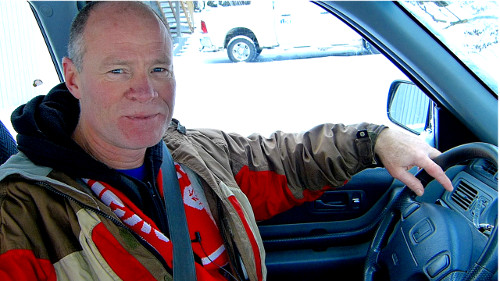 I too downshifted a manual car because that was how I was taught to drive. This is a very old method of driving a manual car.And as well, the other thing that a lot of people are going to ask is:
I too downshifted a manual car because that was how I was taught to drive. This is a very old method of driving a manual car.And as well, the other thing that a lot of people are going to ask is:
"why do we teach students how to downshift for the purposes of a road test?"
The reason that we teach you to downshift for the purposes of a road test is to demonstrate you have due care and control of the vehicle.
That when you go around the corner, you're not going to stall and stop the vehicle because you can't find the correct gear for the speed the vehicle is travelling.
What downshifting teaches you for the purposes of a road test is which gear is appropriate for the speed that the vehicle is traveling.
So therefore, if you go around the corner you slow down to 20 kilometers an hour or 15 miles an hour you know that the vehicle is probably either going to go into second gear or third gear, depending on the gearing in the transmission.
But most of the time, to go around the corner on the right-hand turn, you're going to shift down to second gear in a 5-speed transmission.
Why We Teach Students to Downshift
And in a big truck, you're probably going to shift down to fourth.
And you need to know that, and you're going to learn that during training when your preparing for a road test.
 In most vehicles, when turning right and you don't have to stop, you're going to shift a manual car to second gear.The other problem with that however, is that when we teach students to downshift, they think they have to downshift all the time.
In most vehicles, when turning right and you don't have to stop, you're going to shift a manual car to second gear.The other problem with that however, is that when we teach students to downshift, they think they have to downshift all the time.
When in fact you don't.
Brakes Were Unreliable...When Your Grand Pappy Learned to Drive Stick
One more point, why do we downshift - why do we continue to downshift?
We continue to downshift because in the 1940s--a long long, long time ago when Grandpa drove cars--the brakes were unreliable.
So we downshifted to ensure that in fact we did come to a stop at the intersection.
The problem with that is that we still continue to do it today thinking that brakes are not reliable.
When in fact brakes are reliable.
If you open the cover of the master cylinder - underneath the in the engine compartment there, you'll notice that there's two chambers in there.
The braking system on every vehicle regardless of whether it's air brakes or whether it's hydraulic brakes is divided into two independent subsystems.
Modern Braking Systems Won't Fail
So if one braking system fails--the front brakes on your vehicle fail--the ones on the rear are still going to work.
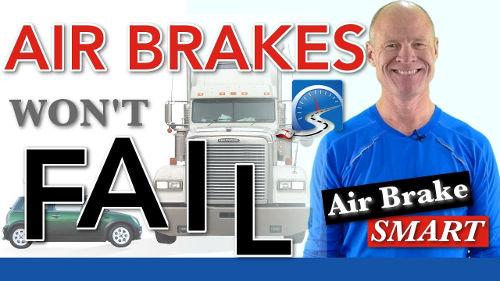 Modern braking systems won't fail because they're divided into 2 independent sub-systems. If one fails, the other will continue to work, allowing you to stop the vehicle.And you're going to come to a stop safely.
Modern braking systems won't fail because they're divided into 2 independent sub-systems. If one fails, the other will continue to work, allowing you to stop the vehicle.And you're going to come to a stop safely.
And you've got to change the brakes out anyway, so you might as well just use the brakes.
And as well, on slippery conditions you're going to have much more control if you just use the brakes as opposed to shifting down.
So again, downshifting for everyday driving - don't do it, it's just a waste of time.
And it's a lot of energy for nothing.
Use the brakes.
But if you are going down long steep downgrades, and especially the bigger the vehicle, you're going to need that extra braking power from the engine.
So we're going to go for a little drive here just show you how I drive my 5-speed manual in the snow.
And it is slippery today because it's around 0°C (32°F) and it's snowing.
And just to give you some idea how to do this - just using the brakes on a 5-speed transmission, we're going to hook up the cameras, go for a drive.
 DO NOT downshift in inclement weather. You could lock up the tires and go out of control. Use the brakes gently and sparingly to keep the tires rolling to maintain control.
DO NOT downshift in inclement weather. You could lock up the tires and go out of control. Use the brakes gently and sparingly to keep the tires rolling to maintain control.
Demonstration of Driving & Shifting
You could see there on the slippery conditions that as soon as I shifted into second gear, the tires started to grab and get traction.
The reason you're doing that is because you're not in a low gear that's going to spin the tires.
When you spin the tires you are going to lose traction.
When you're in a taller gear, you get more torque and the wheels are actually getting traction.
You can see here i just left it in 3rd gear until the engine started to bog down.
You can see that on the tachometer here.
And I go around the corner nice and easy.
As soon as I shift into second gear, you can see here on the tachometer that I'm shifting into second and now I'm in 3rd gear.
And it's slippery conditions here, because the snow and ice.
And actually schools not in today because we're on the Christmas holiday.
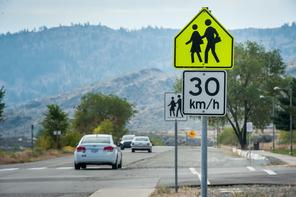 School speed zones are applicable only when school is in session. During Christmas and summer holidays, these signs are NOT applicable.So I don't have to slow down to 30kph (20mph), I only have to slow down to 50 kilometers an hour (30mph).
School speed zones are applicable only when school is in session. During Christmas and summer holidays, these signs are NOT applicable.So I don't have to slow down to 30kph (20mph), I only have to slow down to 50 kilometers an hour (30mph).
I'm just below 50kph (30mph) for both hands on the steering wheel keeping good control of the vehicle because I'm in the snow here.
And i'm going to make the left-hand turn here and I'm going uphill here so I can just use the hill to slow down.
I just shift down to second gear.
I come around the corner.
You can see that the wheels are spinning in second gear - so as soon as I shift the third it gets traction again.
And again, I'm in third gear here.
I shift the second and come around the corner.
I'm using the brakes to slow down because I have more control of the vehicle.
And I get off here and the road is not plowed and I put it back into third gear to get more traction.
Again I'm staying near the center of the road because there's people walking around shovelling their driveways and those types of things.
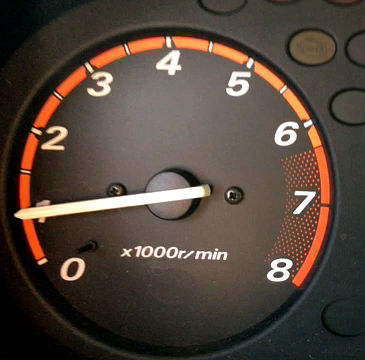 When slowing in a manual car with a gas engine, brake until the the tachometer drops to 1,000rpm and then push in the clutch and come to a complete stop.I'm going slow and travelling 40 kilometers an hour less than 40 kilometers an hour which for you in the states would be about 20 miles an hour.
When slowing in a manual car with a gas engine, brake until the the tachometer drops to 1,000rpm and then push in the clutch and come to a complete stop.I'm going slow and travelling 40 kilometers an hour less than 40 kilometers an hour which for you in the states would be about 20 miles an hour.
And I am in third gear and again i just use the brakes.
Bring the Tachometer Down to 1,000 RPM
Right there, I push the clutch in and come to a stop.
And I shift out of third back to first gear.
I shift quickly into second because I'm going to get more traction; even with my steel studded snow tires on the truck.
And again, I got into second gear.
No vehicles coming, and again the rear end starts to kick around because the tires are spinning as I'm in second gear.
Now I'm going to get up here and I'm going to get on a bit of a slippery section and I'm going to show you that downshifting will potentially cause you to do damage to the drivetrain over a long period of time.
It's not just one day that it's all going to drop out; it's going to be incrementally.
 Rev matching is a racing technique to control the vehicle through high-speed turns. Rev matching is NOT a technique for driving a manual car in everyday situations.That you're going to do undo damage to the drivetrain and eventually what you're going to end up doing is you're getting up changing out the clutch, which any of you have had to do a clutch job, you know that it's anywhere from a thousand to five thousand dollars to change out the clutch.
Rev matching is a racing technique to control the vehicle through high-speed turns. Rev matching is NOT a technique for driving a manual car in everyday situations.That you're going to do undo damage to the drivetrain and eventually what you're going to end up doing is you're getting up changing out the clutch, which any of you have had to do a clutch job, you know that it's anywhere from a thousand to five thousand dollars to change out the clutch.
You saw that it revved down quite a bit there on the tachometer - I just kept my foot on the throttle and the engine climbed back up by itself because it's in third gear.
Gearing in Honda is Low
And the gearing in this Honda is actually quite low.
And I just shift to fourth gear there and actually I'm doing 50 kilometers an hour and i'm going to show you how to do this.
And you match rev.
And I'm going to to skip here - I'm actually going to go down to second gear and I'll show you this.
You see match rev, you actually rev it up when you push the clutch in as well.
And one of my pet peeves is over revving the engine, so there's really no need for you to have in third gear here.
And now I'm just kind of working the steering wheel to go around this corner on the slippery conditions here.
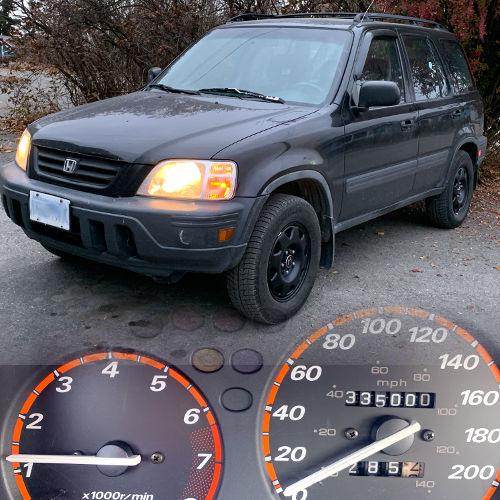 In different manual cars, there will be minor differences in the gearing of the transmission. Look in the owner's manual for specific details.And I'm just keeping my foot off the throttle and you can see it's revving up and I am using the engine braking to go down that hill a little bit.
In different manual cars, there will be minor differences in the gearing of the transmission. Look in the owner's manual for specific details.And I'm just keeping my foot off the throttle and you can see it's revving up and I am using the engine braking to go down that hill a little bit.
I'm not actually shifting down or shifting up and because you're on compromised conditions, I just want to use gentle, easy, very subtle touches on the controls.
And again I'm just coming up here and braking the vehicle.
I'm in third gear.
There's nobody coming.
I shift down to second and go around the corner slowly.
Because in compromised conditions like this, when it's slippery you don't want to brake and steer at the same time.
And you especially don't want to be shifting gears around the corner.
You want to have the vehicle in the gear that you need to go around the corner before you start turning the steering wheel.
Because if you're trying to steer and shift and brake all at the same time, especially in the wintertime as it is right now, you are probably going to end up going straight through the intersection.
We're not going to come to a stop.
Shift Down to Go Around the Corner
And again we're coming up here, we're just letting it idle down.
It comes right down and I'm in second gear and I can just go around the corner...actually I'm in fourth gear, now I shift the second.
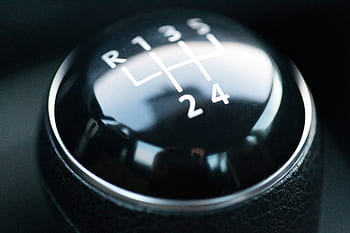 When slowing to go around corners or respond to changing traffic conditions, you're going to select a lower gear that will match the vehicle's speed.I screwed that one up!
When slowing to go around corners or respond to changing traffic conditions, you're going to select a lower gear that will match the vehicle's speed.I screwed that one up!
And again, on a manual transmission, the equation for fuel economy is the highest gear for the lowest rev.
So the faster you can move through the gears when you're accelerating, the better fuel economy you're going to get.
Because you're going to be able to get into your tallest gear more quickly, and you're going to bring your revs down and you're going to get better fuel mileage.
You're going to get better fuel economy because the engine is not working as hard and it's going faster.
So you want to try and move through the gears as quickly as possible, and that's regardless of whether you're driving a five-speed, six speed, or driving a 9, 10, 13, 18, or 15 speed.
It doesn't matter.
Equation for Better Fuel Economy
That equation works for all manual transmissions: the highest gear for the lowest rev - it's that simple.
And the faster you get through the gears, the better fuel economy you're going to get.
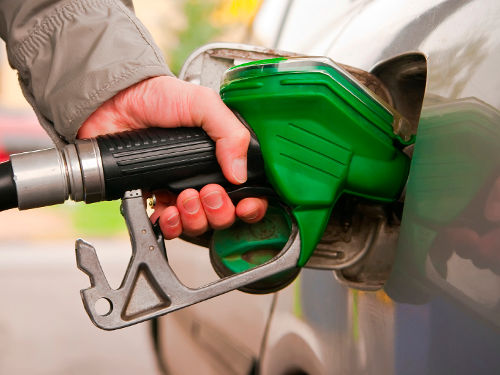 When driving a vehicle with a manual transmission, the highest gear with the lowest engine speed will provide the best fuel economy.And for those truck drivers and professional drivers watching this video, there are companies that do pay you a fuel bonus.
When driving a vehicle with a manual transmission, the highest gear with the lowest engine speed will provide the best fuel economy.And for those truck drivers and professional drivers watching this video, there are companies that do pay you a fuel bonus.
So if you work through the gears faster, you're going to make more money because you're going to get that fuel bonus.
And we like making more money.
So again I'm in fourth gear here, and I'm just coming up and using the brakes.
Right there, you can see that it starts to bog down on the engine.
As soon as it lugs down, that's when you push the clutch in.
And we come to a stop.
So I'm going downhill here you can see i'm just using the brakes and I'm not changing any gears or pushing the clutch in.
Now i'm going around the corner here.
I'm going to shift down to second gear because I'm slowing right down and around the corner nice and easy.
Don't touch the clutch and I'm in second gear, so i can let the RPM come down quite low and actually have to come to a stop here so I push the clutch in.
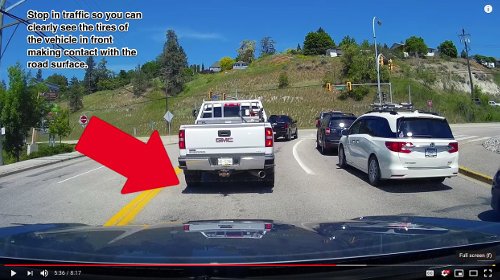 When stopping in traffic, leave the selector in gear until you come to a complete stop - 4th gear for example. When the vehicle comes to a complete stop, shift back to first gear.I'm stopped and I go back into first gear.
When stopping in traffic, leave the selector in gear until you come to a complete stop - 4th gear for example. When the vehicle comes to a complete stop, shift back to first gear.I'm stopped and I go back into first gear.
And if you're taking a road test on a manual transmission - now this...
If you're taking a road test on a manual transmission--this may not be true in the UK (United Kingdom) or Europe-- you are not required to downshift.
Downshifting for a Road Test
You are required to show that you can shift down into a gear--a lower gear--to go around a corner that you're not going to lose momentum or stall the vehicle.
If you do that on a road test [CHUCKLING] then yes, the that is either going to gain significant demerits or you're going to potentially fail your road test.
But you are not required to downshift to slow the vehicle down for the purposes of a road test.
Now I may stand corrected on that point in Europe - they may be require you to downshift, but I'm not aware of that criteria for the purposes of a road test.
 On a road test you will have to shift to a lower gear, but don't downshift to slow the vehicle.They simply want to see that you can keep the vehicle moving around the corner; that you can shift down to the appropriate gear so you're not going to stall the vehicle or bring the vehicle to a stop.
On a road test you will have to shift to a lower gear, but don't downshift to slow the vehicle.They simply want to see that you can keep the vehicle moving around the corner; that you can shift down to the appropriate gear so you're not going to stall the vehicle or bring the vehicle to a stop.
Because you want to be able to maintain forward momentum.
And again here, the light has changed here.
We see that, and I just slow down and right now I push the clutch in just before I'm about to come to a stop.
And then I shift from third back to first gear.
And now again we can see that all the cars are bunched up in front of us, which means they're slowing down in preparation for that red light that you can see up in the distance there.
And I'm just maintaining my gap in front of me between the vehicles and myself here in front of me and I'm not downshifting.
You can see that the rpms are down quite low.
There's no danger of the vehicle stalling.
And if I just want to come to a stop, which I'm going to have to here momentarily, then I just work the throttle.
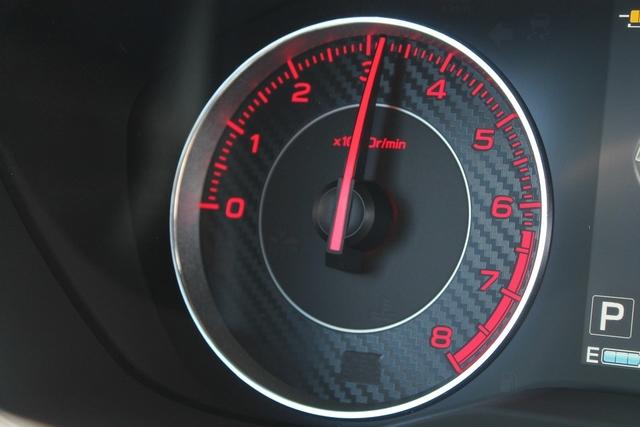 The tachometer provides valuable information when learning to drive a manual car.And right now - now it's going to come to a stop and I push the clutch in.
The tachometer provides valuable information when learning to drive a manual car.And right now - now it's going to come to a stop and I push the clutch in.
And I change down into second gear because I may or may not have to come to a complete stop, which I don't.
And I just bring it into second gear and actually now i'm going to go right back to first gear.
Conclusion
Quick review of "NOT" downshifting for the purposes of slowing the vehicle.
Historically we downshifted because brakes were unreliable well into the 1960s.
In the late nineteen sixties, we implemented dual braking systems.
If you look in the engine compartment directly here in front of the steering wheel you'll find the master cylinder.
If you take the lid off the master cylinder & look inside you'll see two chambers in there.
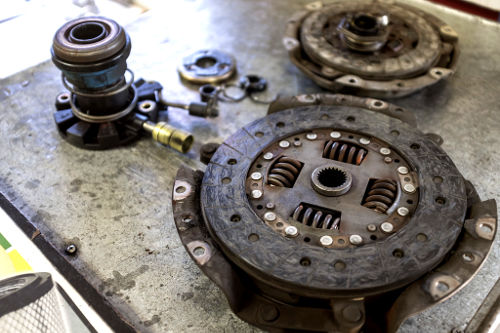 If you ride the clutch or have poor clutch control when shifting a manual car, you will do damage to the clutch assembly. This repair could be in the thousands of dollars.One is for the front and one is for the rear brakes.
If you ride the clutch or have poor clutch control when shifting a manual car, you will do damage to the clutch assembly. This repair could be in the thousands of dollars.One is for the front and one is for the rear brakes.
Air brake systems are the same: there a dual air brake system, so if one side fails, the other side will continue to work normally; therefore, brakes will not fail.
And since the 1960s, advances in technology and component parts that make up the braking system are much more reliable.
And I would argue that in this day and age, brakes are not going to fail at all.
They're almost one hundred percent bulletproof.
It is a very rare case that a braking systems will in fact fail.
As well, we have such a large generation overlap, that this driving technique of downshifting to save the brakes has been passed on from generation to generation - grandparents to parents to children and sometimes that overlap is 10, 20 sometimes 30 or 40 years in really long cases.
So this has been passed down from generation to generation and we haven't revisited this, even though advances in technology - automotive technology have improved and created braking systems that will not fail.
Yes, as well somehow it's become hooked into virility, mostly with men, but some virility with women as well.
It's right up there with being able to drink copious amounts of alcohol, always getting the best deal when you go shopping, and sexual prowess with the opposite sex.
Finally not down shifting - automatic transmissions - they don't downshift either.
They just shift down to the next gear, when it is the appropriate road speed to shift down.
They don't really create a whole lot of engine braking in automatic transmissions.
Therefore because of that feature in automatic transmissions, all the engineers in the world can't be wrong in terms of downshifting.
Finally if you are down shifting and using the drivetrain to slow the vehicle, it's going to cost you a lot of money over time because even if you match rev, you're never going to do it perfectly.
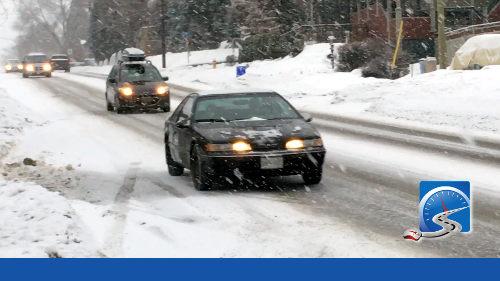 Many drivers feel they have more control of the vehicle when driving a manual car.And what happens is that the tires are spinning at a very fast speed, you rev the motor up and you put these two things together.
Many drivers feel they have more control of the vehicle when driving a manual car.And what happens is that the tires are spinning at a very fast speed, you rev the motor up and you put these two things together.
You're never going to get a perfect match on that unless you're a professional race car driver and you're never going to get a perfect match on that and you're going to shock the drivetrain.
And over a period of time you're going to wear out the clutch and the other pieces.
And again, I come back to my main point or my main argument: why would you use a $15,000 drivetrain to save $400 brakes.
It just doesn't make any sense financially.
And even in a big truck, why would you use a thirty thousand dollar drivetrain to save two-thousand-dollar brakes.
It doesn't make any sense.
The other challenge with downshifting is that during preparation for road test, driver education programs - we teach students how to downshift.
And the reason that we teach them downshift is because they have to demonstrate on a driving test that they have due care and control of the vehicle when they go around the corner.
And they slow down, they have to pick an appropriate gear so they don't stall in traffic.
As well when they're going uphill in a big truck and the vehicle just cannot maintain that high gear, they have to downshift.
 In North America about 15% of the vehicles are manual cars; but in the rest of the world 85% of vehicles are manual cars.Unfortunately after the driver education program, they go on to think that they have to downshift all the time.
In North America about 15% of the vehicles are manual cars; but in the rest of the world 85% of vehicles are manual cars.Unfortunately after the driver education program, they go on to think that they have to downshift all the time.
When in fact they don't.
We simply teach it for due care and control of the vehicle.
So you don't have to downshift - simply use the brakes.
And now again, I just reiterate this is for everyday normal driving - just come up to the stoplight or the stop sign or the intersection wherever you're stopping, and just use the brakes.
If you're downhill braking...yes you do have to downshift and you have to use the engine braking power to assist in getting that vehicle down the hill, especially the larger the vehicle, the more you're going to have to use the engine braking power to assist.
And if you're a professional race car driver, yes you're going to downshift to shoot out of the corner and get more speed as you're coming out of the other side of the corner, but most of us are not race car drivers.
And most of us are not doing large down hill braking, so we don't need the engine braking power.
Even I was doing this well into my truck driving career until somebody said to me, oh you don't need to downshift, you're just using fuel.
And they were referring to a big truck because you've got to throttle up to downshift to get the gears to synchronize.
And when your match revving, again your throttling up to downshift.
So you're just using extra fuel.
So if you just use the brakes, again you're going to get better fuel economy.
When you get better fuel economy, you can put that saved money towards doing a brake job every two or three years in your vehicle.
So don't downshift.
Question for my smart drivers:
Do you still continue to downshift and why?
Leave a comment down in the comment section there - all that helps out the new drivers learning how to drive after they get their license.
 Even though a transport truck has all the same components as a manual car, learning to drive and shift a tractor-trailer is somewhat different.I'm Rick with Smart Drive Test.
Even though a transport truck has all the same components as a manual car, learning to drive and shift a tractor-trailer is somewhat different.I'm Rick with Smart Drive Test.
Thanks very much for watching.
If you like what you see here share, subscribe, leave a comment down in the comment section.
As well, hit that thumbs up button.
Check out all the videos here on the channel if you're working towards a license or starting a career as a truck or bus driver - lots of great information here.
As well, head over to my website for more great information and online courses that you can purchase.
Stick around to the end of the video, funny bits and links to the other videos and to my website.
Thanks again for watching.
Good luck on your road test and remember, pick the best answer not necessarily the right answer.
Have a great day.
Blooper
Bye now.
DAUGHTER: Look at that fancy house.
This green one?
Yes DAUGHTER: Are you finished the video?
No, not yet honey.
Just a little bit more to do.

